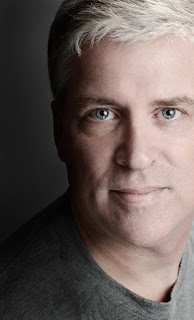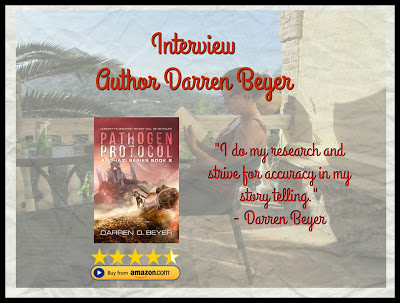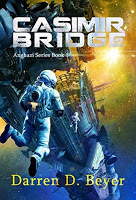Oct
to share my interview with Author Darren Beyer. Darren Beyer’s latest book ‘Pathogen
Protocol’, the second book in the Science Fiction Anghazi series has just been
published on October 10th and has had some raving reviews. Publisher’s Weekly
calls the book “fast-paced,
action-packed, stellar storyline. A riveting intergalactic adventure filled
with space battles, mystery, and even a hint of romance.” Find out
more about this book and the author here today!
About the Book:
greatest secret is uncovered. An insidious plot threatens its future.
A corporate and government conspiracy, led by CEO-turned-politician Gregory
Andrews, has succeeded in taking over the Applied Interstellar Corporation
(AIC), and its stockpile of hyperium, the element that enables interstellar
travel. But Andrews didn’t get everything. AIC’s leader, Jans Mikel, escaped to
a hidden base on the alien moon of Helios, where he harbors the company’s
greatest secrets, the most profound of which is that humans are not alone in
the galaxy.
Now, as Andrews seeks to finish off AIC, Mandi Nkosi sets off to help Jans and
AIC forge new alliances that could provide a path to their salvation. Their
journey takes them beyond the realms of known space and uncovers revelations
about humanity’s future that will shake the foundations of science. On Eridani,
AIC soldier Grae Raymus commands a fledgling resistance aimed at buying Mandi
and Jans the time they need. But Grae uncovers that Andrews is little more than
a pawn in a larger game, one that threatens more than just AIC, while Mandi
discovers an even deeper, more insidious evil at play. With humanity’s future hanging
in the balance, Mandi and Grae fight to save the people they love, and along
with them, all of mankind.
The Facts:
|
Publication
Date: |
October
10th, 2018 |
|
Series:
|
Anghazi
#2 |
|
Genre:
|
Science
Fiction |
|
Pages:
|
338
|
|
Formats:
|
eBook,
Paperback |
|
Available
at: |
The Interview:
-
Why did you start writing Science Fiction?
I’ve been a sci-fi fan my entire life, and I essentially lived it for 10 years
during my time as a Space Shuttle Engineer for NASA at Kennedy Space Center.
When I decided to write a novel, they say to write what you know, and I know
science and space, so sci-fi was a natural fit. I’m also a stickler for realism
and accuracy, and through writing I have an opportunity to enable readers to
learn about space and science without knowing they are learning.
-
What do you love most about Science Fiction?
fantasy are interesting genres because they give authors a blank canvas to
define their universes, and readers the latitude to interpret authors’ words
against their own creativity to visualize these new worlds. No other genres
enable this to the same extent.
-
You worked for NASA. Does this help with writing Science Fiction?
for NASA has been instrumental in bringing realism to my writing. Not only does
it enable me to weave detailed technical descriptions into the story line,
which adds tremendously to the believability, but also craft solutions to
problems the characters face based on this knowledge.
-
Tell us about Pathogen Protocol?
Protocol is the second book in the Anghazi Series. It picks up right where book
one, Casimir Bridge, left off, and jumps straight into the action. While book
one was more about corporate greed and corruption, Pathogen Protocol carries a
much more sinister undertone that has implications for humanity as a whole. The
first book had very limited references to any sort of extraterrestrial
involvement. I dropped some clues that something was amiss, like a brief
discussion on a news channel about how the element hyperium, which enables
interstellar travel, could only be found in one location. I also drop hints
about how humanity could have progressed so far technologically so quickly. But
I don’t directly indicate any sort of help from “out there” until the
very last chapter. In Pathogen Protocol, I reveal much more in this regard. I’m
not really giving anything away by saying so–the cover depicts the main
character, Mandi, emerging from a crashed life boat, looking up at some ruins.
In the background, two moons are visible in the red sky, giving a clue that
this is an alien world. A lot of back story comes out in Pathogen Protocol, but
it pales in comparison to the amount that I took out and moved into book three.
I just didn’t have enough pages to write it all in. The next book will be a
challenge in this regard.
-
Publisher’s Weekly called your book a riveting intergalactic adventure. Is this what you set out your book to be or did it develop this way while writing?
isn’t exactly a proper description, as everything takes place squarely in our
galaxy within galactic spitting distance of Earth. But the story does span
multiple star systems, and reveals some interesting information about
humanity’s origins. From the beginning I knew I needed the entire series to
take place across multiple systems, not only because it opens up your canvas to
depict new worlds, but also because it was necessary to support the underlying story.
It is core to a number of key elements.
-
In your books people live on another planet. Is this something you would want?
depend on the planet… The only planet we’d likely be able to live on within
our lifetimes is Mars, and even that will present significant challenges. For
the first colonists, it would be a one-way trip. Would I want to do that? The
notion is tempting, but I think that never again being able to see Earth, or
even go outside without a pressure suit, would put me in the “no”
column. If somehow we were to conquer interstellar travel and also find an
Earth 2.0 somewhere out there, the prospect would be tempting.
-
Why should we read the Anghazi series?
Anghazi series is more than just another sci-fi read. I’ve woven in currently
relevant topics like corporate overreach and government corruption, as well as
a number of historically accurate topics ranging from the British East India
Company to nuclear forensics, to the Denisovans, an ancient humanoid species
related to homo sapiens. As with all my technical descriptions, I do my
research and strive for accuracy in my story telling. SPOILER ALERT: On top of
that, I will be presenting in the third book an interesting fictional account
of how humanity, Earth, and other habitable planets came to be. I’m very
excited to get the concepts behind this put into words.
About ‘Casimir Bridge (Anghazi #1):
interstellar survey ship has gone missing.
A nuclear
terror plot is thwarted just outside Washington, D.C. And it’s an election
year. Mandisa “Mandi” Nkosi is a young reporter who, while on a trip to
Johannesburg to connect with her roots, is contacted by an anonymous source
with evidence that material seized from a nuclear terror plot will point
squarely at one of humanity’s most important companies as the supplier. The
source also unveils that the “evidence” against the company – Applied
Interstellar Corporation (AIC), a science and technology behemoth with more
corporate and political foes than can be counted – is a setup, and part of a
plot to destroy AIC and gain control of its technological secrets. The deeper
Mandi digs, the more of a target she becomes. What follows is a heart-pounding,
unforgettable ride through the hallowed halls of big government, far-flung star
systems, and the revelation of a conspiracy that runs so deep, Mandi’s life,
and the future of humanity, are put at stake.
About the Author:
 Darren
DarrenBeyer was born in Washington, D.C., but quickly became a child of the world.
His family moved overseas when he was age two and together they traveled
extensively throughout his childhood. Darren draws on these experiences to add
an element of realism and depth to his writing. At the age of six, he was
awakened in the middle of the night by his mother to watch live pictures being
broadcast from the surface of the moon during the Apollo 17 mission. At that
moment, even at so young an age, he decided to pursue a career related to the
space program. In high school, he took classes in math and science. In college
at Virginia Tech, he enrolled in the engineering school and received a degree
in aerospace engineering in 1989. Following graduation, he was hired by NASA at
Kennedy Space Center, where for nearly ten years he worked as a Space Shuttle
experiment engineer. While there, he worked on the Hubble launch, as well as
numerous Space Lab and other scientific missions. Experiments he was
responsible for ranged from telescopes to frog life support. He conducted
astronaut training, performed installations onboard the Shuttle just prior to
launch, and was part of the recovery crew following landing. Darren has had the
honor of working onboard every Space Shuttle orbiter except Challenger. In late
1998, Darren left NASA to become an entrepreneur, and, after more than
seventeen years, an author. He is a student of science and technology and is an
instrument-rated private pilot. Darren lives in California near San Francisco
with his wife, dogs, cats and fish.
For more
information about Darren please visit his website. Or visit him on Twitter and
Facebook.
You might also like:

Maureen is a mom, wife, nurse, and Ravenclaw living in the Netherlands. She spends her days juggling mom-life, reading, blogging, planning date nights with her husband and working as a nurse. Maureen also is a big Anglophile, loves cooking, Gilmore Girls, Bridgerton and Harry Potter.. Always! Facebook | Instagram




















